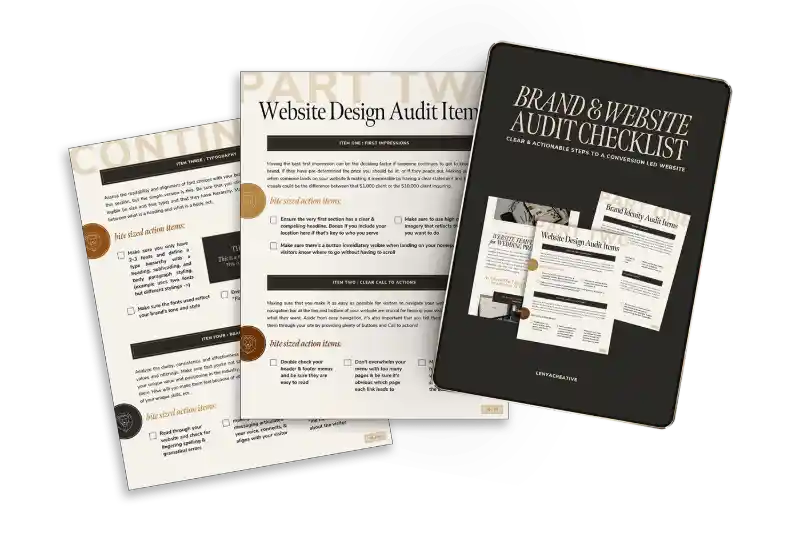Time To Get Real About Website Platforms
(The Full Breakdown from a Designer Who’s Been in the Trenches)
Most “Showit vs Squarespace” blog posts read like tech-heavy reviews or simply gloss over the surface (or it’s people battling it out in reddit threads). So I really wanted to break it down from a web designer perspective for my clients—for the wedding industry pros and creative rebels who are hungry for a platform that’s gonna knock their socks off.
I’ve personally used Showit, Squarespace, and WordPress—in real life, for real businesses—and I’m breaking it all down for you, designer-style. No jargon. No bullsh*t. Just straight up clarity so you can pick the platform that actually works for you.
Ready to meet the contenders? Let’s goooo!
Showit
For creative rebels who want full visual freedom
Squarespace
For DIYers who want something quick, clean and easy
WordPress
For those who want total control, scalability and high-functioning SEO + sales power
Spoiler: There’s no universal “best website platform” — but there is a best one for wherever you’re at

Round One: Design Flexibility
Showit – For the artistic creatives who want a website that doesn’t look like every other one out there, Showit is your ride-or-die.
| STRENGTHS | WEAKNESSES |
| Absolute creative freedom—drag, drop, layer, animate | Because of its flexibility, layouts can get messy or overwhelming |
| Create stunning, custom-looking sites without touching a single line of code | Not as simple as Squarespace’s plug-n-play boxes |
| A ton of Showit templates available that are GORGEOUS | Blog setup still requires WordPress, so there’s a tiny learning curve |
| Doesn’t automatically optimize for mobile, so you need to double-check every. single. change. and things can quickly go whack |
Squarespace – For the minimalist who needs it quick, clean & easy.
| STRENGTHS | WEAKNESSES |
| Super easy to use with pre-built elements like buttons, accordion menus and forms | Customization is limited without code (and even then, some basic things still requires CSS know-how) |
| Built-in style guides to help maintain consistency. Built in sections = less design overwhelm | You’ll outgrow it fast if you want next-level design freedom |
| Clean templates, good typography options | Limited design flexibility – your site might look like 1,000 others |
WordPress – For the design-obsessed who either know the platform well or hire dev / design help.
| STRENGTHS | WEAKNESSES |
| Unlimited customization – sky’s the limit if you have the skills | Requires plugins, potential dev help, and patience (aka: not beginner-friendly) |
| Perfect for highly custom website experiences | The backend can feel clunky and confusing |
| You can build literally anything | Start up costs can be more expensive with hiring a pro, but usually levels out over time |
Leader of the Pack (Your Round Winner): Showit

Round TWO: Ease of use
Showit – Ideal for visual thinkers who want drag-and-drop design with just enough flexibility to make it feel custom.
| STRENGTHS | WEAKNESSES |
| Intuitive drag-and-drop builder, perfect for visual thinkers | Still requires WordPress for blogging which can cause confusion and tech issues |
| Great blog on their website for support with helpful videos | There can be a lot going on between the pages, canvases, elements, canvas sites, customization and WordPress templates (which can get confusing and cause issues) |
| AMAZING customer support | You have to build items such as “buttons”, “accordions”, “forms”, “cards”, and other “element” functionalities rather than simply choosing a pre-made one. |
Squarespace: For the no-fuss DIYer who needs a site live, like, yesterday.
| STRENGTHS | WEAKNESSES |
| Clean, beginner-friendly UI | Can be limiting for bold, personality-packed brands—unless you know code or hire a designer to push the platform further |
| All-in-one platform makes building pages, blogs, and content pretty intuitive | |
| Easy to stay on-brand using style settings and pre-made elements |
WordPress: For those willing to climb the learning curve to unlock serious backend power.
| STRENGTHS | WEAKNESSES |
| Most powerful design and steamlining potential once you do the research (or hire a designer) | Steepest learning curve |
| WordPress has been out there for a while so there are loads, and loads, and LOADS of resources out there for you to learn the platform | Tech-heavy, but you’re golden once you research all the tools (or hire someone to help you out in the beginning) |
| You own your website which is pretty damn nice |
Leader of the Pack (Your Round Winner): Squarespace

2 Minute Free Website Audit
Is your website holding you back?! Snag a free video audit packed with actionable tips to optimize your website!

The Brand & Website Audit Checklist
Actionable Items for an aligned & conversion-led website!

Round Three: Blogging & seo
Showit: Best of both worlds: stunning visual design + powerful WordPress blogging for SEO.
| STRENGTHS | WEAKNESSES |
| Uses WordPress for blogging = strong SEO power | If you’re not thinking about on-page SEO while designing, you can quickly start making SEO mistakes without even knowing it |
| Easy to edit SEO titles, descriptions, alt text, etc | WordPress Gutenburg editor is lets be honest.. the worst |
| Fairly customizable for single post blog design and category listing page design | WordPress connection setting errors can cause technical and design issues which can be super frustrating as it just takes one small setting to mess a whole section up! |
| If you want to customize or add functionality, you’ve got to pay the highest tier to get more advanced SEO & Gutenberg editing capabilities |
Squarespace: Decent SEO tools built in, ideal for folks who want simple content updates without diving deep into strategy.
| STRENGTHS | WEAKNESSES |
| Decent built-in SEO settings | Less customizable, not as powerful as WP |
| Blog setup is simple and clean | Because it’s limited on customization, you may be inclined to use title tags too much (for aesthetics and design) which isn’t good for SEO |
| Flexible blog types (testimonials, galleries, etc) | Not as many SEO tools built in to help you with target keywords, etc. (Like the Yoast plugin for WordPress) |
WordPress: The ultimate SEO powerhouse for brands investing heavily in blogging and search visibility.
| STRENGTHS | WEAKNESSES |
| Unmatched SEO capabilities with tons of advanced plugins for SEO help | You need plugins and solid strategy to make it work |
| Fully customizable blog layouts for optimized user experience which is good for SEO & conversions | Steeper research/learning curve than the other two sites |
| Ability to streamline the blogging process while also creating unique blog designs for better user experience |
Leader of the Pack (Your Round Winner): WordPress

Round Four: E-Commerce, Rentals & Digital Products
Showit: Solid for service-based businesses with light e-comm needs or simple digital product offerings.
| STRENGTHS | WEAKNESSES |
| Shopify Lite integrations possible and fairly solid for simple digital product sales | No native e-commerce support, you’ll have to use an e-commerce platform and integrate it |
| Relative design freedom and custom look for shop pages available | WP integration can get glitchy (similar connection issues as the blog) |
| You’re able to combine a super beautiful site with a functional and user friendly shopping experience | Tedious product setup in Showit (and might hit your Showit page limit depending on how many products you have) |
| You can integrate a checkout platform like Thrivecart into your already beautiful website using checkout links | Managing multiple platforms can be overwhelming |
| WordPress integration options for things such as simple & minimal products and rentals | To customize your shopping experience with WordPress, you’ll need to know a bit of code |
Squarespace: Great for simple & small online shops.
| STRENGTHS | WEAKNESSES |
| Easy to set up your shop and get selling ASAP | Limited customization options |
| Intuitive user experience for selling digital products | Pricing does jump up with e-commerce and even more when wanting to introduce robust features & add ons |
| Simple, minimal shop designs | Not scalable for big shops |
| Simple & intuitive shop marketing capabilities |
WordPress: The gold standard for full-scale e-commerce shops.
| STRENGTHS | WEAKNESSES |
| Customize your shop as much or as little as you want with the power of plugins | More of an upfront setup and training recommended |
| Great SEO features to get your products seen organically on google | Not the most DIY-friendly |
| The flexibility, scalability and features are seriously limitless with WordPress. There’s virtually nothing you can’t do | Will need to make suer you’re site and shop is up to date on it’s tech to run properly |
| Super streamlined shop update process—you don’t have to create a new page for each product every time, instead just put in the product details and the page will be designed by a template you set up once. |
Leader of the Pack (Your Round Winner): WordPress

Round Four: Digital Courses & Other Integrations
Showit: Best for integrating your chosen external platform
| STRENGTHS | WEAKNESSES |
| Flexibility to integrate your preferred course or membership platform | No built-in advanced features such as shops, courses, or other education capabilities |
| Managing multiple systems can get complicated |
Squarespace: Good for those wanting an all-in-one site with basic online course & membership capabilities
| STRENGTHS | WEAKNESSES |
| All-in-one setup for memberships | Lacks robust course features |
| Quick to get started | Not scalable for full learning platforms |
| Can get quite costly with course features |
WordPress: Great for full-scale courses and aaallll the integration capabilities
| STRENGTHS | WEAKNESSES |
| Use LMS plugins like LearnDash or MemberPress | Requires plugin management and additional plugin fees |
| Build fully custom course hubs | Needs a strategy to start or pro support to get started (then, once again, you’re golden) |
| Ultimate control and scalability |
Leader of the Pack (Your Round Winner): WordPress
The All-Round Winner: Which One’s YOUR Match?
Choose Showit if…
- You want stunning design flexibility without coding
- You’ve got a bold visual brand and want your site to reflect it
- Blogging is important but you don’t want a full WP build
Choose Squarespace if…
- You want something fast, functional and no-fuss
- You’re a beginner or solo service provider who just needs to be online now
- You have a few products you’d like to sell asap with little curve
Choose WordPress if…
- You need scalability and custom solutions
- You’re selling lots of products, courses or doing content marketing at scale
- You’re tech-savvy (or have a dev / web designer on call)
Wondering Which Web Platform Is The Lenya Pride Favorite?
While there’s no one-size-fits-all, Showit is hands-down the go-to for most of my clients—especially the creative rebels in the wedding industry who want to cut through the noise and stand out.
So what sets Showit apart and why do I keep coming back to it?
Its limitless design flexibility paired with WordPress power on the backend.
That combo means we can create a visually stunning, fully custom site and integrate the systems and features you love and need—whether that’s selling digital products, launching a course or showcasing your client experience in a way that feels effortlessly aligned with your brand.
So yes, you get a site that’s STUNNING—but also one that’s built to convert, scale and grow with you as your business evolves. That’s why I recommend Showit again and again.
THE WRAP UP: There’s No Wrong Choice, Just Wrong-For-You Choices
Choosing the best website platform isn’t about what’s trending.
It’s about what will actually support the bold, badass brand you’re building.
Your website should do more than look damn good—it should be working overtime for you.
And if you’re still stuck in the “Squarespace vs Showit vs WordPress” decision paralysis, let’s chat! I’m always happy to give my insight based on your needs.









